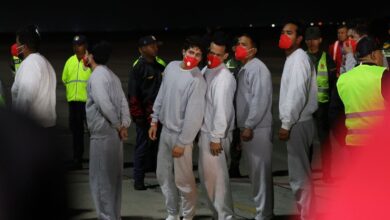
Association for Defending Victims of Terrorism – Bonnie Docherty, Senior Researcher in HRW, wrote an article about U.S. Cluster Munition Transfer to Ukraine.
She writesPresident Joe Biden’s recent decision to transfer U.S. cluster munitions to Ukraine will exacerbate a humanitarian crisis and break with a widely followed international norm. The move encourages the proliferation of weapons that have been banned by over 120 countries because they endanger civilians both during strikes and for months, years, and even decades afterward. Having witnessed the gruesome impact of cluster munitions first-hand, I find the U.S. rationale for transferring them weak on multiple fronts.
Cluster munitions, which Russia has used extensively in Ukraine, disperse dozens or hundreds of smaller submunitions, or bomblets, across a broad area, the size of a city block. Each of these submunitions shatters into metal fragments that can tear off limbs and inflict fatal wounds. They cause civilian casualties at the time of attack because they cannot discriminate between soldiers and civilians. In addition, many do not explode on impact, lingering like landmines and posing an ongoing threat to the local population.
In news conferences on July 7, U.S. government officials justified the transfer of artillery projectiles containing cluster submunitions known as Dual Purpose Improved Conventional Munitions (DPICM) on several grounds. National Security Advisor Jake Sullivan and Undersecretary of Defense for Policy Colin Kahl contended that Ukraine already faces a massive challenge to clear unexploded ordnance, that technological and targeting safeguards will reduce risks, and that Ukraine needs more ammunition to defeat Russian forces.
While acknowledging that cluster munitions harm civilians, U.S. officials argued that using them will not significantly worsen the situation in Ukraine because the country already has to clear large numbers of Russian munitions, including submunitions and landmines. In addition, Ukraine has pledged to record where they use the weapons, and the U.S. has committed to support clearance efforts.
This reasoning ignores the threats to individual civilians waiting for their land to be cleared. Every unexploded submunition endangers a curious child, a farmer plowing a field, or a refugee returning home. The submunitions’ presence also slows reconstruction.
Children are the most common victims, as my Human Rights Watch colleagues and I found in Iraq in 2003. There, the U.S. widely used cluster munitions containing DPICM submunitions, including M42 and M46 submunitions for artillery projectiles, and M77 submunitions for rockets.
“Cluster bombs sometimes look like beautiful things,” a doctor at Iraq’s Najaf Teaching Hospital explained to us at the time. “Children like to play with them. [They] are here and there, everywhere on farmland.” Twelve-year-old Abbas Hussain, who was at that hospital, picked a submunition up on a road, thinking it was a toy, but it exploded and ripped off half of his hand.
Rami Ali Hassan Shebli was not as lucky. In October 2006, the 12-year-old boy picked up a strange object in a field near his village of Halta, in south Lebanon. Rami wanted something to toss back at his older brother Khodr, who was dropping pinecones on him from a tree. A bystander recognized the object as a submunition and yelled for Rami to drop it. The submunition exploded when Rami’s hand was behind his ear, killing him instantly. My team and I arrived as two men shoveled bloody dirt into a box and Lebanese Army deminers destroyed 15 unexploded DPICM submunitions, all left from an Israeli cluster munition attack in an adjacent field.
Clearance is dangerous, time-consuming, and expensive. Doing it well involves highly trained professionals with specialized equipment carefully marking and examining land meter-by-meter. But environmental conditions, such as heavy rains or flooding, can frustrate even the most careful demining operations. Adding any number of submunitions to the contamination can slow clearance operations and exacerbate the danger for demining teams and for civilians who seek to return home. To make matters worse, residents often try to remove submunitions from their land or their homes themselves, which puts them at risk and complicates clearance for the professionals.
Human Rights Watch has already documented how Ukraine’s use of cluster munitions from its own stockpile directly led to the death and injury of civilians in populated areas in and around Izium during efforts to dislodge Russian forces. Ukrainian officials have publicly denied these claims, and there is no indication that Ukrainian authorities have documented or investigated them.
In addition, by using cluster munitions against Russian troops, Ukraine will most likely contaminate its own agricultural areas critical to its economy. Returning farmers, like those from other conflict zones before them, will have to choose between risking their lives to till a contaminated field or losing their livelihood by waiting for the slow process of clearance. Given that Ukraine was a major exporter of grains before the war, especially to the Middle East, North Africa, and Europe, impediments to farming could also affect global food supplies.
The decision to transfer cluster munitions is a disturbing change of course for the U.S. Since its widespread use of the weapons in 2003, the U.S. has only used cluster munitions once, for a single strike in Yemen in 2009. The last U.S. cluster munition manufacturer ceased production in 2016. Furthermore, President Biden had to waive a U.S. policy prohibiting transfers of cluster munitions with a more than one percent failure rate.
The transfer decision also runs counter to international progress, notably due to the adoption of the Convention on Cluster Munitions in 2008 and increasing stigmatization of cluster munitions it has generated.
Finally, rather than revert to the era when the U.S. last used cluster munitions, the U.S. and Ukraine, as well as Russia, should heed these calls. They should cease transfer and use of cluster munitions to protect civilians from an inhumane weapon and the mistakes of the past.





